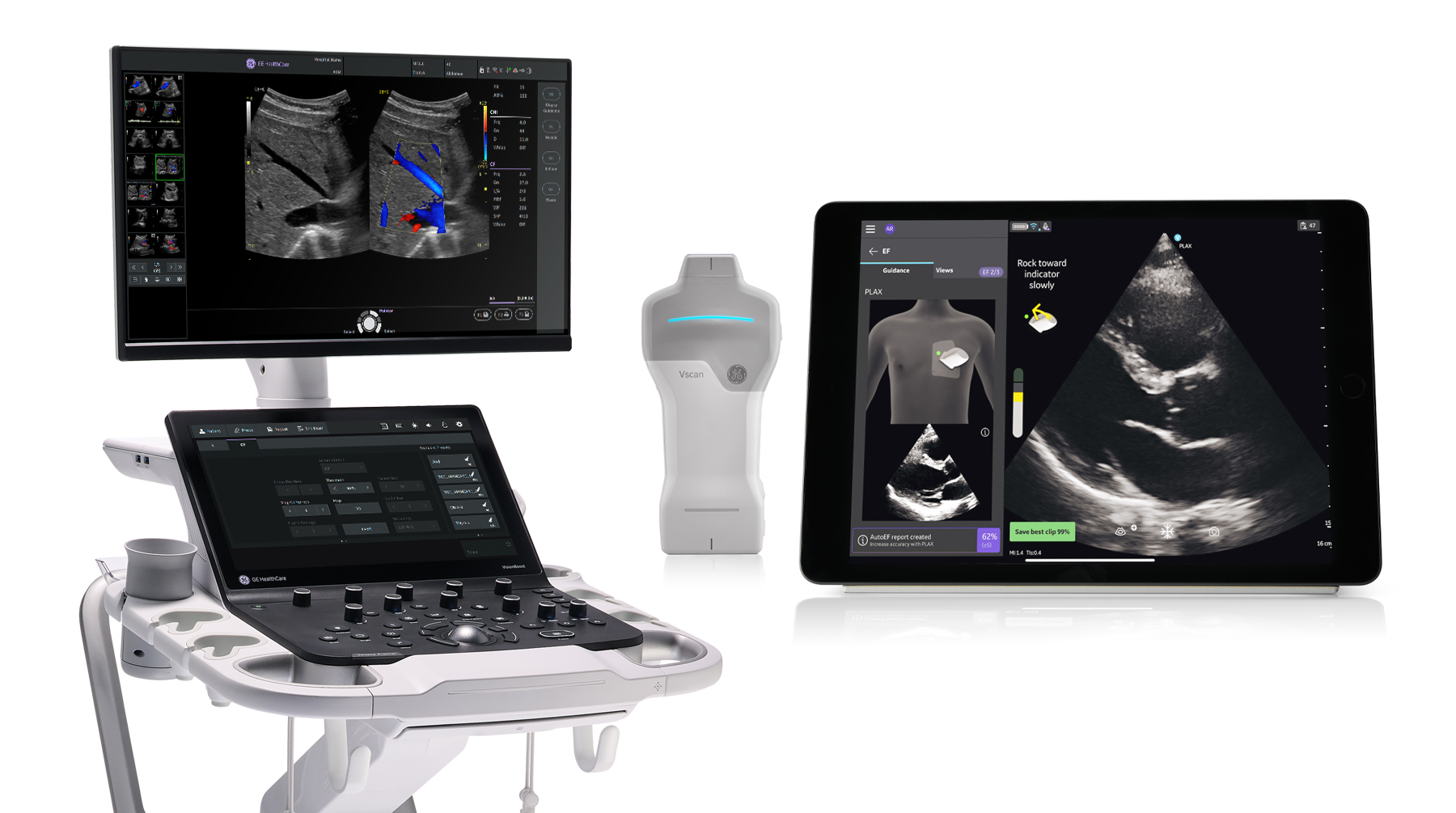As ultrasound becomes more deeply woven into primary care1, clinicians in this space are finding it easier than ever to leverage multi-organ, abdominal, cardiac, lung, and other types of scans to grow their practices and improve the quality of their patients’ experiences. Advanced and intuitive systems are putting the power of ultrasound in the hands of more general practitioners, helping them augment care, increase their scope of capabilities, and generate new revenue streams.
The growing relationship between ultrasound and primary care medicine was on full display during GE HealthCare’s recent webinar with Dr. Martin Altersberger, medical doctor, resident in cardiology, and deputy director of the Echo Laboratory in the state hospital of Steyr with a special interest in lung ultrasound, echocardiography, POCUS, and teaching.
During the presentation, aptly titled The Primary Care Ultrasound Journey with Versana Premier™ and Vscan Air™ SL Featuring Caption AI™, Dr. Altersberger takes us through multiple cases that illustrate the benefits of ultrasound in primary care. He emphasized the importance of understanding these benefits for new users and demonstrated how GE HealthCare’s Versana Premier and Vscan Air SL ultrasound systems are driving primary care scans forward through ease of use and diagnostic confidence.
The primary aims of the webinar included:
- Identify cases where multi-organ ultrasound would be clinically beneficial
- Learn to distinguish relevant pathologies in the heart, lungs, and abdomen
- Gain an overview of regions to be scanned and understand how to perform the scans
- Discover and integrate new ultrasound technology into primary care practices
Here is a quick look at two of the cases discussed.
1. Diagnosing Cause of Dyspnea with Ultrasound
Dr. Altersberger presented a case of a 70-year-old patient presenting with severe dyspnea (shortness of breath). Using the Vscan Air SL, Dr. Altersberger showed multiple views of the patient’s heart, indicating a significant reduction in left-ventricular function. The Vscan Air’s color Doppler feature helps to identify regurgitation or stenosis that warrants further clinical assessment and evaluation. Additionally, in the webinar, he demonstrated how to check for pleural effusion (abnormal accumulation of fluid in the lungs).
Offering informed guidance on how to best position patients during heart and lung scans, Dr. Altersberger also showed how the pulsed wave (PW) Doppler feature, which is available on both the Vscan Air SL and Versana Premier ultrasound systems, can help assess and track fluid in echocardiography.
2. Identifying Tricuspid Valve Endocarditis with Ultrasound
Dr. Altersberger also presented a case of a 24-year-old man who has a history of substance abuse and schizophrenia, presenting with severe dyspnea as well as tachypnea (rapid breathing) and syncope (loss of consciousness). He first conducted a lung scan that indicates the possible presence of pneumonia or pulmonary embolism before showing a primary care ultrasound of the patient’s heart to get further context. Multiple views of the cardiac anatomy reveal severe tricuspid valve endocarditis.
Using Versana Premier, Dr. Altersberger specifically showed how color Doppler can reveal fluid backflow in the patient’s liver veins. He reiterates that, despite learning curves and time constraints, it is possible for primary care providers to quickly and easily obtain multiple views of the heart for the most confident diagnosis.
The presentation ends with Dr. Altersberger showing scans of the patient’s tricuspid valve after replacement and follow-up abdominal scans that revealed splenic infarction, also using the Versana Premier system.
Creating Imaging Datasets to Increase Context and Confidence
As new ultrasound users often face uncertainty regarding imaging properties and variables, Dr. Altersberger stressed the importance of creating datasets to better inform examination and diagnosis. Before taking questions from audience members, Dr. Altersberger emphasized some final teaching points, including the importance of primary care physicians scanning as closely to where patients are feeling pain as possible, considering medication side effects in abdominal scans, and how ultrasound can be a critical technique in determining the cause of kidney and urinary issues.
Unlocking the Potential of Ultrasound in Primary Care
Versana Premier* ultrasound was built specifically with primary care clinicians in mind, helping them quickly and easily embrace ultrasound utilization in a way they never could in the past and deliver high-quality care to a wide range of patients every day. Easy to learn, easy to scan, and easy to diagnose, Versana Premier helps clinicians quickly and confidently diagnose their patients, expedite treatment, and increase their overall scope of care
Additionally, Caption AI* on Vscan Air SL handheld ultrasound can significantly aid primary care physicians in performing cardiac scans by providing real-time, step-by-step guidance to capture diagnostic-quality images. This AI-driven software simplifies the process of obtaining accurate cardiac views, even for non-experts, by offering visual prompts and a quality meter to ensure optimal image capture. Furthermore, features like AutoEF automatically calculate the left ventricular ejection fraction.

